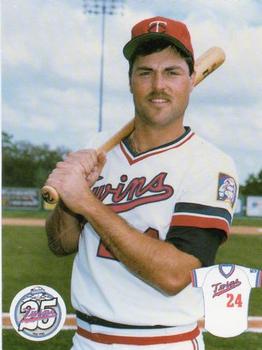Post by dougiejays on Feb 22, 2020 0:28:10 GMT -5

In a stunning turn of developments, the AL East-leading Toronto Blue Jays have shipped starting first baseman Tom Brunansky and infielder Spike Owen to Pittsburgh for two young pitchers and a pair of draft picks. The Jays will acrquire 26-year-old swingman Gary Eave – currently on the DL with a shoulder injury – as well as top pitching prospect Ben McDonald and Pittsburgh’s 1991 1st and 3rd round draft picks.
There’s not much of an argument to be made that this trade will make this season’s Blue Jays better. The departure of Brunansky will leave a large hole in the middle of the order and cost the Blue Jays a stellar defensive first baseman, while Owen had a terrific season a year ago when he logged an .807 OPS as Toronto’s primary shortstop. (He had already been shifted into the weak side of a platoon this season, so his offensive punch won’t be missed quite as much as Brunansky’s.) Eave is a talented but inexperienced pitcher who was mostly used as a starter in Pittsburgh, but given the Jays’ stacked rotation will likely slide into a middle relief role with Toronto once he is healthy. But even if he performs well in that role, his impact isn’t likely to match that of a middle-of-the-order slugger, and the other pitcher in the deal, McDonald, is likely several years away from the bigs.
Despite these concerns, there are three key reasons why this deal makes sense for Toronto:
1 – Financial Flexibility
The deal appears to be financially motivated, as the Jays will save almost $7M this season and nearly $9M next season in shipping out Brunansky’s multi-year contract. By removing Brunansky from the books, the Jays transition from a team struggling to break even this season into a team that will be able to net a small profit. Perhaps more importantly, if the Jays had brought back most of their important players on expiring contracts, they could have been on track to lose upwards of $15M next season. By moving Brunansky now, they clean up their books for next year – and acquire talent that might not have been available elsewhere.
2 – Overall Talent
While the deal doesn’t improve the Jays for this season, that’s not to say it’s a bad baseball trade on its face – Toronto did acquire three good young assets in the deal. Eave has elite stuff and should have some role on the major league staff for the next several seasons, while McDonald was Pittsburgh’s top pitching prospect and profiles at least as a sixth starter. And with Pittsburgh in the midst of a full-scale midseason roster restructure, there’s no telling where the draft picks could land.
3 – Bullpen Depth
Before the trade Toronto was primed to lose four major league relievers to free agency, and a fifth reliever, Dan Quisenberry, is 37 years old and may be nearing the end of his effectiveness. But now if the Jays are just able to re-sign closer Tom Niedenfuer, they can slide Eave in beside incumbents Randy Myers and Todd Worrell and potentially have a dominant bullpen for years to come.
While this trade could cost the Jays a few wins this season, it could potentially extend their contention window in the long run. If the Jays miss out on the playoffs or get knocked out early due to a lack of offence, there may be some regret in their future – but this trade can’t really be judged for at least three or four years.
Several options to replace Brunansky
Replacing both Brunansky’s offence and defence with a single player will be difficult, but Toronto does have several different options to help fill the void.
The first shot will likely go to 28-year-old Joey Meyer, who has never received an extended big-league opportunity despite solid all-around batting numbers at AAA over the past five seasons. Should Meyer prove to be the Quad-A player that many in the game think he is, the Jays could shift pieces around to work in defensive stalwarts such as outfielder Terry Harper, second baseman Rance Mulliniks or third baseman Rob Wilfong.
But their secret weapons may be a pair of career minor-leaguers. 32-year-old Dwight Lowry has exactly 1 major league plate appearance to his name – a two-run single in a September call-up in 1986. But there’s been some buzz amongst Blue Jay brass that he has developed a major league power tool over the past couple of seasons and 10 home runs in 124 Triple-A plate appearances so far this season may be a sign of things to come. Lowry is a catcher by trade, but projects as a first baseman or DH in the big leagues. Meanwhile, 31-year-old Lloyd McClendon lacks Lowry’s pop, but he does have the big-league pedigree Lowry lacks: 5 partial seasons spent mostly with Kansas City. Unfortunately, he has combined for a .228/.300/.311 mark in those seasons for just a .611 OPS, which is one reason why he’s now plying his trade in AAA. But McClendon’s calling card is his defence. A solid defensive backstop, he’s also drawn rave reviews for his work at first base and in left field, and can slide into the other corners in a pinch. If Toronto’s main focus is replacing Brunansky’s defense, they could do worse than call on the versatile McClendon.



